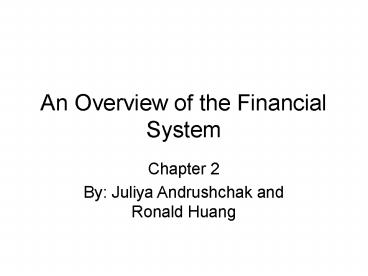An Overview of the Financial System - PowerPoint PPT Presentation
Title: An Overview of the Financial System
1
An Overview of the Financial System
- Chapter 2
- By Juliya Andrushchak and Ronald Huang
2
Web Exercises
- 1.
3
Web Exercise
- 2. a). Dow will increase value from 13,074 to
13,187 in three months - b). 0.8643 increase
4
ATT Brief History
5
ATT Timeline 1876 to 2001
ATT issues its stock ATT issues its stock McCaw acquired McCaw acquired 35.5 Bill invested in 35.5 Bill invested in Spinoff the wireless Spinoff the wireless
in an IPO in an IPO (ATT Wireless) (ATT Wireless) acquisitions upgrades acquisitions upgrades unit unit
1876 - Founded 1876 - Founded 1984 1984 1994 1994 1996-2000 1996-2000 2001 2001
1877 1877 1991 1991 1995 1995 2000 2000
Bell formed and stock Bell formed and stock ATT acquires NCR ATT acquires NCR Restructuring - Splitoff Restructuring - Splitoff Issued a tracking stock Issued a tracking stock
issued to 7 shareholders issued to 7 shareholders Lucent for ATT Wireless for ATT Wireless
NCR
ATT
Debt - bank loan or Debt - bank loan or ATT - shares sold on ATT - shares sold on Need more funds Need more funds Corporate (convertible) Corporate (convertible) No cash generated, No cash generated,
private borrowing private borrowing NYSE and Munich NYSE and Munich (11.5 billion) (11.5 billion) bond, foreign bond bond, foreign bond divestiture divestiture
IPO - Bell financed IPO - Bell financed Borrow funds and Borrow funds and Divestiture Divestiture Receive cash, tax free, Receive cash, tax free,
through equity through equity acquire new assets acquire new assets Issue different shares Issue different shares new share class new share class
( 7.3 billion) ( 7.3 billion)
6
- Debt finance the using a bank loan (indirect
finance) or borrow privately (direct finance) - A. Graham was the borrower-spender
- Equity seven original shareholders held the
stock after the IPO. Deal details worked out with
a broker (no underwriting in this case)
7
Post-Divestiture Events
- ATT issues its own stock on the primary market.
Shares are traded on NYSE and Munich exchanges.
The new company is valued at 34 bill from the
total of 149.5 bill. Shares traded on the
secondary market. - Equity issued through an investment bank.
- Divestiture anti-trust lawsuit monopoly
issues.
8
Classifications of Financial Markets
- Secondary Markets
- Exchanges
- Trades conducted in central locations (e.g.,
Toronto Stock Exchange and New York Stock
Exchange) - Over-the-Counter Markets
- Dealers at different locations buy and sell
9
Subsequent Restructurings
- NCR acquired for 7.3 bill. Finance through
long-term debt (commercial paper, and convertible
corporate bonds, bearer form or registered,
foreign bonds) and secondary issues. - Use short- and medium-term debt for cash needs,
and invest excess funds in money market
securities and other liquid financial
instruments. Adopt a dividend policy. - Investment of 35 billion made from 1996-2000 in
acquisitions and upgrades major need for
financing.
10
Classifications of Financial Markets
- Debt Markets
- Short-term (maturity lt 1 year) the Money Market
- Long-term (maturity gt 10 year) the Capital
Market - Medium-term (maturity gt1 and lt 10 years)
11
Stock Issues and Restructurings
- 1995 split off into three separate companies
NCR, ATT, and Lucent. - 2000 issued a tracking stock to track the
performance of the wireless division. Created a
different stock class. - 2001 spun off ATT Wireless to the current
shareholders. Distributed as a dividend. - 2005 proposed merger with SBC.
12
Financial Market Instruments
- Stock- equity claims in the net income and assets
of a corporation - Mortgages- loans to households or firms to
purchase housing, land, or other real
structures, where the structure or land serves as
collateral for the loans. - Corporate Bonds- long term bonds issued by
corporations with very strong credit
ratings - Govt of Canada Bonds- are issued by the federal
government to finance its deficit. - Other
- Canada savings bonds
- Provincial and municipal bonds
- Government agencies securities
13
Internationalization of Financial Markets
- International Bond Market
- Foreign bonds - sold in a foreign country and
denominated in that country - Eurobonds denominated in a currency other than
the country in which it is sold - Eurocurrencies foreign currencies deposited in
banks outside the home country
14
- World Stock Markets
15
- Transactions Costs
- Financial intermediaries make profits by reducing
transactions costs. - They reduce transactions costs by developing
expertise and taking advantage of economies of
scale. - Risk Sharing
- Create and sell assets with low risk
characteristics and then use the funds to buy
assets with more risk (also called asset
transformation) - Lower risk by helping people to diversify
portfolios
16
Asymmetric Information
- Adverse Selection
- Before transaction occurs
- Potential borrowers most likely to produce
adverse outcomes are ones most likely to seek
loans and be selected - Moral Hazard
- After transaction occurs
- Hazard that borrower has incentives to engage in
undesirable activities making it more likely that
loan wont be paid back
17
Financial Intermediaries
18
Size of Financial Intermediaries
19
Regulation of Financial Markets
20
Regulation of Financial Markets
- Primary Reasons for Regulation
- Increase information to investors
- - Decreases adverse selection and moral hazard
problems - - Securities commissions force corporations to
disclose information - 2. Ensuring the soundness of intermediaries
- Prevents financial panics
- Restrictions on entry/assets/activities,
disclosure, deposit insurance, limits on
competition
21
Financial Intermediaries Keywords
22
Any Questions?































